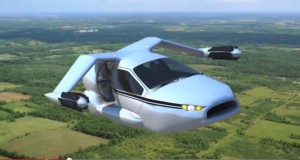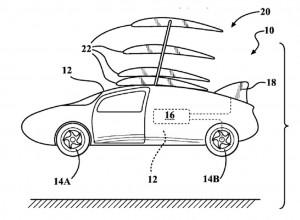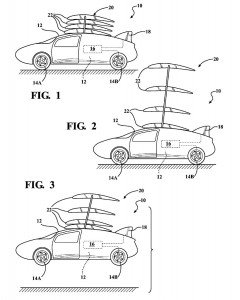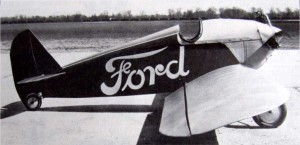Wouldn’t it be great to fly home after a long day’s work – quite literally taking to the air rather than getting stuck in a traffic jam? That’s a fantasy nearly as old as the auto industry itself, and now, it seems, Japanese giant Toyota Motor Co. may be working up plans to develop a flying automobile, at least according to a recent patent filing.
How serious Toyota is about building a flying car the company isn’t saying, but it wouldn’t be nearly the first to give the idea a try. Industry pioneer Henry Ford was an early proponent, abandoning the idea of a flying version of his Model T only after the fatal crash of a friend and chief co-pilot. Meanwhile, a group of MIT grads has already begun testing their own flying car concept even as a Defense Department research group explores the idea of sending soldiers into battle on a flying motorcycle.
Forget Blade Runner, or the Jetsons, for that matter. Few expect to see a world in which commuters routinely take to the air anytime soon. But proponents believe that at least some well-heeled motorists could leapfrog traffic in the not-too-distant future.
A newly discovered U.S. patent application filed by Toyota last year shows one intriguing way to get there. The document’s summary describes “An aerocar including a stackable wing and methods for morphing the stackable wing…atop the aerocar.”
What to do with a flying car’s wings has been one of the biggest stumbling blocks since the days of Henry Ford. A 1950s-era prototype that actually logged some air time relied on detachable wings that could be left behind and stored at the airport.
The Toyota proposal, patent application 20150246720, doesn’t show how its aerocar would generate the thrust needed to propel it through the air, but that’s another issue entirely.
It’s not quite clear who first came up with the idea of a vehicle that could fly over or drive on conventional roads, but Henry Ford was certainly an early pioneer. One project was called the “sky flivver,” a reference to the nickname given his once wildly popular Model T.
Ford eventually abandoned his company’s efforts when a close friend and company test pilot was killed in a crash during an attempt to set a distance record, but as late as 1940, Ford declared, “Mark my word: a combination airplane and motorcar is coming. You may smile, but it will come.” Ford Motor Co. produced a 3/8 scale model as late as 1958 of a flying vehicle it dubbed the Volante Tri-Athodyne.
In 1949, inventor Moulton Taylor actually got airborne with his Aerocar. It had 30-foot folding wings that could keep it aloft at up 110 mph, and four wheels for cruising down the highway. But only five were built, including the original prototype.
While the concept remained a staple of science fiction, efforts to let cars take wing seemed to falter for a few decades, but recent developments in lightweight materials, advanced engines and digital computer technology have put wind in the sails of a number of visionary entrepreneurs.
Among projects now underway, the Moller Skycar M400 would use four swiveling turbofans for a design that would allow it to take off and land vertically. The French Xplorair also would permit vertical take-offs. An unmanned version is scheduled to stage a demonstration flight in 2017.
One of the most advanced projects was launched by a group of MIT graduates who have formed the Massachusetts-based Terrafugia. Their prototype, the Transition, has already run a series of manned flights. The company hopes to follow up with an updated production model, the TF-X. Think of it as the Toyota Prius of the air, as it would use a hybrid gas-electric powertrain to give it a range of 500 miles. The hope is to have the Terafugia TF-X in production by 2021.
DARPA, the research arm of the Defense Department, has been an active proponent of flying vehicles, a concept that could make it easier to get soldiers and gear into battle than with conventional airplanes and helicopters. The Transition program, launched in 2010, has yet to achieve that goal, but DARPA hasn’t given up.
And the Army Research Lab this summer completed a nine-month test of a hovering motorcycle-like machine that could have been plucked out of an episode of Star Wars. The military plans to move ahead on the Hoverbike project, which was developed by the British firm Malloy Aeronautics.

The Terrafugia TF-X would travel 500 miles using a plug-in hybrid power train. However, it's not likely to be ready for another decade.
“It can transport troops over difficult terrain and when it’s not used in that purpose it can also be used to transport logistics, supplies, and it can operate in both a manned and unmanned asset. It can also operate as a surveillance platform,” explained Mark Butkiewicz, an executive with Suvice Engineering, a Maryland firm that will build prototypes of the Hoverbike.
There’s no word on whether a civilian model might follow.
One way or the other, the idea of a flying car just won’t go away. But for the first time, there may be real reason to believe the concept will fly off the screen from a sci-fi movie and into daily reality.





Since no one should be allowed to operate a flying car without proper FAA training and licensing and there are minimal places where it would be safe or acceptable to use a flying car, I wouldn’t be spending money on a flying car when my company has safety and sales challenges to address.
On September 11, 1973, a flying pinto for the James Bond film,”The Man With The Golden Gun”, suffered a fatal, inflight, structural failure. The designer and pilot died when a strut and/or wing failed.
Bob Wilson, Huntsville, AL
Instead of calling well handling cars such as BMWs a driving machine using the same technology as airplanes we would call automobiles the cars that you want to fly! LOL. Hey! its friday:)